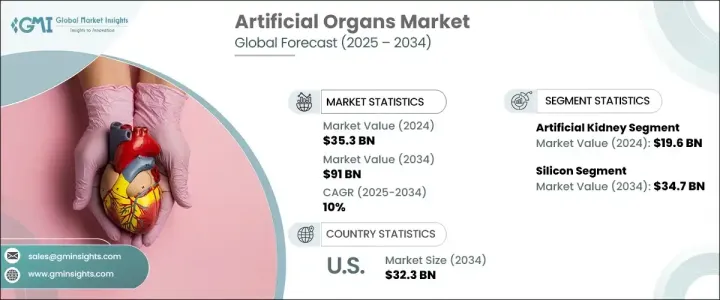
세계의 인공 장기 시장은 2024년 353억 달러로 평가되었으며 2025년부터 2034년까지 10%의 연평균 복합 성장률(CAGR)을 나타낼 전망입니다.
의료기술의 진보에 따라 인공 장기는 점점 생체기능의 대체, 지원, 강화가 진행되어 환자가 정상적인 상태를 되찾는 데 도움이 되고 있습니다. 기증자 장기의 부족이 심각화하는 동안 인공 대체 장기는 실행 가능하고 장기적인 솔루션을 제공하고 장기 제공에 대한 의존을 크게 줄일 수 있습니다.

끊임없는 연구개발의 노력은 인공 장기의 설계에 있어서의 혁신을 추진해 기능성의 향상과 환자의 결과의 개선을 가능하게 하고 있습니다. 헬스케어 기업이나 정부 기관으로부터의 투자가 증가하고 있어 인공 장기 산업은 향후 10년간에 대폭 확대될 전망입니다.
| 시장 범위 | |
|---|---|
| 시작 연도 | 2024년 |
| 예측 연도 | 2025-2034년 |
| 시작 금액 | 353억 달러 |
| 예측 금액 | 910억 달러 |
| CAGR | 10% |
시장은 인공신장, 간, 폐, 췌장, 심장, 기타 장기 등 장기 유형별로 구분됩니다. 만성 질환 치료를 필요로하는 환자가 증가함에 따라 혁신적인 인공 신장 솔루션이 필수적인 의료 개입으로 부상하고 있습니다.
재료 부문에는 실리콘, 플라스틱, 강철 및 기타 생체 재료가 포함됩니다. 실리콘은 2024년에 36.2%의 점유율을 차지했으며, 2034년에는 347억 달러에 이를 것으로 예상됩니다. 고성능 바이오 머티리얼에 대한 수요 증가가 인공 장기의 보급에 기여하고 있습니다.
미국의 인공 장기 시장은 2023년에 117억 달러를 창출했고 2034년에는 323억 달러에 이를 것으로 예상됩니다. 만성 질환 환자 증가는 보급을 촉진하고 고급 의료 솔루션에 대한 수요를 증가하고 있습니다. 장기 부전율의 상승은 의료 기관에 최첨단 기술에 대한 투자를 촉구하고 있습니다. 업계가 보다 효율적인 솔루션 개발에 주력하는 가운데, 인공 장기는 현대 건강 관리에 필수적인 존재가 되고 있습니다. 연구 확대 및 제조 개선은 업계 성장을 가속화하고 주요 기업은 생산 능력 강화를 뒷받침하고 있습니다. 지속적인 발전으로 인공 장기 채용은 증가하고 의학과 환자 관리의 미래를 형성하게 됩니다.
The Global Artificial Organs Market was valued at USD 35.3 billion in 2024 and is projected to register a 10% CAGR between 2025 and 2034. As medical technology advances, artificial organs are increasingly replacing, supporting, and enhancing biological functions, helping patients regain normalcy. The demand for these life-saving devices is surging as chronic illnesses and organ failure cases rise, intensifying the need for alternative solutions beyond traditional transplants. With a severe shortage of donor organs, artificial replacements offer a viable, long-term solution, significantly reducing dependency on organ donations. The integration of bioengineered materials and cutting-edge technologies is improving device longevity, compatibility, and efficiency, fostering wider adoption across healthcare facilities.

Continuous research and development efforts are propelling innovations in artificial organ design, allowing for improved functionality and better patient outcomes. Next-generation bioartificial organs, incorporating advanced biomaterials and regenerative medicine, are reshaping the market landscape. As 3D bioprinting technology gains momentum, the production of customized, patient-specific artificial organs is becoming more feasible, accelerating medical advancements. With increasing investments from healthcare companies and government bodies, the artificial organs industry is poised for substantial expansion over the next decade. The rising prevalence of chronic kidney disease, liver failure, and cardiovascular disorders is further intensifying the need for technologically advanced organ solutions, ensuring sustained market growth.
| Market Scope | |
|---|---|
| Start Year | 2024 |
| Forecast Year | 2025-2034 |
| Start Value | $35.3 Billion |
| Forecast Value | $91 Billion |
| CAGR | 10% |
The market is segmented by organ type, including artificial kidneys, livers, lungs, pancreas, hearts, and other organs. Artificial kidneys held the largest market share, generating USD 19.6 billion in 2024. The rising incidence of kidney-related diseases is driving demand, leading to continuous advancements in renal care technologies. With a growing number of patients requiring treatment for chronic conditions, innovative artificial kidney solutions are emerging as essential medical interventions. Expanding treatment options and enhanced medical capabilities are ensuring steady market expansion.
Material segmentation includes silicon, plastic, steel, and other biomaterials. Silicon accounted for a 36.2% share in 2024 and is projected to reach USD 34.7 billion by 2034. Its superior flexibility, durability, and compatibility make it an ideal choice for manufacturing advanced prosthetics and medical implants. Increasing demand for high-performance biomaterials is contributing to its widespread usage in artificial organs. Improved patient outcomes and reduced rejection rates are strengthening market positioning, thus encouraging further research into next-generation materials. As technological innovations refine artificial organ designs, biocompatible materials like silicon continue to dominate the industry.
U.S. artificial organs market generated USD 11.7 billion in 2023 and is expected to reach USD 32.3 billion by 2034. Growing cases of chronic diseases are driving adoption, increasing the demand for advanced medical solutions. Rising organ failure rates are prompting medical institutions to invest in cutting-edge technologies. As the industry focuses on developing more efficient solutions, artificial organs are becoming an integral part of modern healthcare. Expanding research and improvements in manufacturing are accelerating industry growth, pushing key players to enhance production capabilities. With ongoing advancements, artificial organ adoption is set to increase, shaping the future of medical science and patient care.